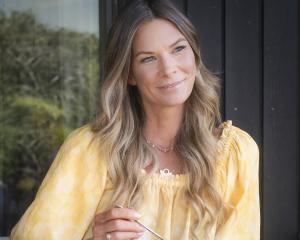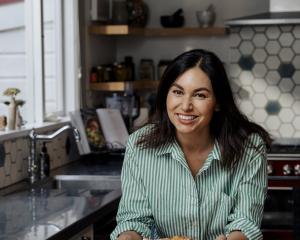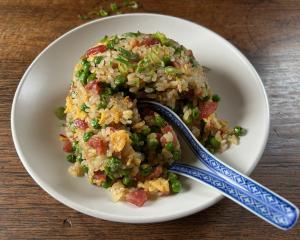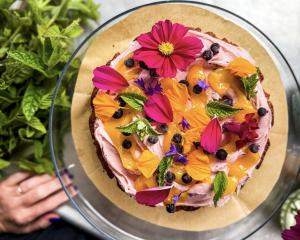To launch the third Selaks New Zealand Roast Day, Selaks invited food writers to a roast lunch at The Grill in Auckland. It's a long way to go for lunch but I learned a lot about slow roasting (roasting at a low temperature for a long time), and not only of meat.
Besides a slow-roast lamb and beetroot salad, a Yorkshire pudding with duck liver parfait and a main of slow-roast rib of beef with potatoes roasted in duck fat, for dessert, consultant chef Sean Connolly had also roasted a pineapple brushed with vanilla and star anise for three hours.
Roasting is cooking food in a dry heat, which caramelises the outside and brings out the flavour, but slow roasting at a low temperature for a long time allows the meat to become tender and cook evenly, so it can be rare (if you like it that way) almost to the edge. Roasting faster in a hotter oven will leave a joint rare in the middle and well done at the edges.
"Give the joint a quick seal in a pan to caramelise it, then turn it to 100degC and leave it for 4-5 hours. That's how I'd recommend anyone cook at home," Connolly said.
The British-born Australian celebrity chef grew up in Yorkshire (his grandparents had emigrated from Ireland) and as a child he enjoyed cooking because he liked making people happy with food.
However, he lost that attitude as he rose up the chef ranks and chased awards for fine dining, of which he won several.
He was into "smokes, foams, bubbles, anything molecular", he said, referring to molecular gastronomy which applies laboratory techniques to food, led by Spanish chef Feran Adria and British chef Heston Blumenthal, and has been the rage in international fine dining for some years.
However, about five years ago his attitude changed when he fronted the television show My Family Feast, which featured the lives and cooking traditions of Australian immigrants and their families.
"We did 13 different nationalities and I realised then how food was like the anchor of families; how it brought people together around the table. It's like a basis for communication," he said.
"That's what I try to explain to young chefs these days. It's all about making people happy and I'd rather a full restaurant serving meat and potatoes than a half-empty restaurant serving bubbles and air. They love this style of cooking - simple food cooked well."
However, his "simple food" is not necessarily what you pop down to the supermarket to pick up.
"'I try to impress them by using the best quality cuts I can find, and I'm not sure if guests really understand that. They see it for what it is - meat and potatoes - but they don't understand I've sourced the best potatoes and the best beef, and that's where it's sometimes lost in translation," he said.
"It's the clever chef, the restrained chef that just puts the food on the plate and says that's enough. It's the chef who's insecure who adds too many flavours and puts too many twists and turns on the dish to try and impress people."
Serves 4
For the beef
1.5kg beef scotch fillet
sea salt
freshly cracked pepper
olive oil
Method
Preheat the oven to 140degC.
Season the beef well with salt and pepper. Place a large frying pan on a medium heat and when it is really hot add the olive oil and carefully place the beef in the pan. Sear the meat on all sides to give a nice brown colour.
Transfer the beef to a roasting tray and place in the oven. Using a meat thermometer to monitor the temperature, remove the beef from the oven once an internal temperature of 54degC is reached. Allow the beef to rest in a warm place for 15 minutes. While resting the internal temperature should rise to 58-60degC for "medium".
For the bearnaise
2 egg yolks
25g water
25g chardonnay vinegar
5g salt
60g whole butter
150g clarified butter
1 bunch tarragon, picked and chopped
Method
Combine the whole butter and clarified butter and melt and keep warm. Bring a pot of water to a simmer. Combine the egg yolks, water and chardonnay vinegar in a mixing bowl, then place the bowl over the pot of simmering water and remove pot from the heat. Whisk continuously until the egg yolk mixture begins to thicken. Remove the bowl from the pot and, while whisking continuously, pour in the melted butter in a thin stream, until combined.
Mix in the chopped tarragon and salt.
To serve
Preheat the oven to 200degC.
Just before serving return the beef to the oven for two minutes to reheat.
Carve the beef into nice slices, sprinkle with sea salt and spoon over the bearnaise sauce and serve with your favourite vegetables.
Suggested wine match: merlot cabernet
serves four
For the lamb
1 shoulder of lamb, bone in, about 1.2kg (he uses alpine merino)
1 Tbsp olive oil
6 garlic cloves, peeled
4 shallots, peeled
½ bunch rosemary
½ bunch thyme
4 whole star anise, dry toasted
1 bottle red wine (he uses pinot noir)
250ml raspberry vinegar (available at most supermarkets)
2 tsp sea salt
1 tsp freshly ground white pepper
Method
Preheat the oven to 160degC.
Season the meat all over. Place a large frying pan on a medium heat and add the olive oil; when the pan is really hot, put in the lamb shoulder. Sear the meat all over to a nutty brown colour, turning as necessary. It will take about 10 minutes to achieve good colour all over.
Transfer the meat to a roasting tray and pour off the fat from the pan. Return the pan to a low heat, add the garlic and shallots and cook a little. Then add the rosemary, thyme and star anise and mix.
Pour in the wine and bring to a simmer.
Reduce by about a third. Add the raspberry vinegar, mix, then pour into the roasting tray with the lamb. Cover with foil and place in the oven at 160degC for 3 hours.
After 3 hours, remove from the oven, remove the foil and allow the lamb to cool until warm.
For the beetroot
1kg baby beetroot
1 bay leaf
1 stick rosemary
2 garlic cloves
35ml red wine vinegar
35g salt 35g sugar
Method
Rinse the beets, then place in a pot and cover with cold water.
Season the water with salt until it is as salty as the sea. Add enough sugar and red wine vinegar so the saltiness, sweetness and acidity are balanced in intensity. Add the bay leaf, rosemary and garlic and bring to a simmer. Cook on a low heat until the beets are tender, about one hour - check with a skewer. Remove from the heat and allow the beets to cool in the liquid. Once cool peel them. The skin should come away easily in your hands. Reserve some of the cooking liquid.
To finish
1 small tub sheep's milk yoghurt
½ bunch mint leaves
100g pomegranate seeds
good quality extra virgin olive oil
sea salt
Method
In a bowl, dress the beets with a little of the cooking liquid, the extra virgin olive oil and sea salt. While the lamb is still warm pull the meat from the bone and arrange on a serving dish with the beets. Place a few dollops of the sheep's yoghurt and then sprinkle with the pomegranate seeds and torn mint.
Suggested wine match: pinot noir
The slow roast
Slow roasts are not new. Some people will remember their grandmothers putting a leg of hogget in the oven on a low temperature to cook for three or four hours while the family went off to church.
Chef Johnny Schwass gives a simple recipe on www.selaksnzroastday.co.nz.
He rubs a leg of hogget with a cut clove of garlic and then salt, leaves it in the oven at 75degC fanbake for eight hours, then turns the heat up to 160degC for 20 minutes to colour the roast. When it is coloured, he removes it from the oven and serves it.
Sean Connolly's tips for slow roasting
• Bone is best - so much flavour comes from the bone, so if you can find great on-the-bone cuts, buy them. My favourite cuts to slow roast are rib of beef and racks of lamb.
• It is possible to overcook meat when slow roasting, so keep an eye on it. Base cooking times on the weight of the meat and temperature of the oven. Use your own judgement too: if you can see the meat is falling off the bone, it's probably done, and further cooking may just dry it out.
• Ensure oven is heated and meat is at room temperature before beginning. This makes it easier to judge cooking times and gives you a head start to cooking a succulent roast.
• Less is more when it comes to roast meat - the flavour of a good piece of meat will speak for itself. I use salt, pepper and extra virgin olive oil to season meat. You can then tart up your roast with all those brilliant sides and sauces - the mix-and-match possibilities of a roast are one of my favourite things about it.
• Use a meat thermometer - it's not cheating, it's common sense! I like to sear the meat first - the result is twofold: it gives a nice colour, and it seals in the juices so that they circulate through the meat.
• Use fresh, local produce where you can. I used to help my grandma dig up the carrots when I was a lad back in Yorkshire; they were massive and so full of that great home-grown carroty flavour.
I don't know if I could see better in the dark, but I loved those carrots. I use the same recipe at The Grill now - it's one of our most popular dishes.











